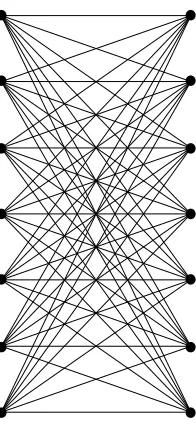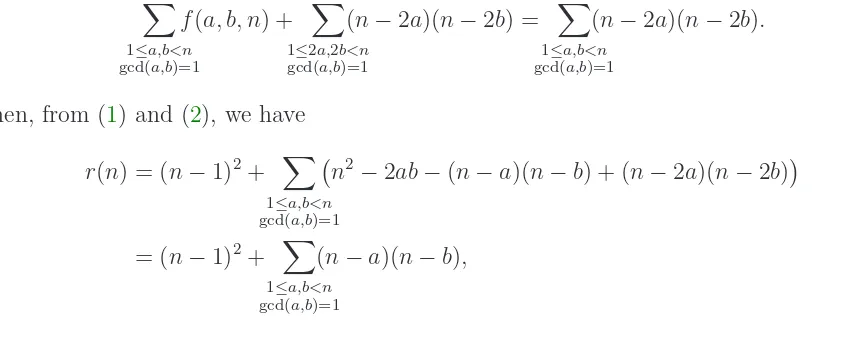23 11
Article 10.8.5
Journal of Integer Sequences, Vol. 13 (2010), 2
3 6 1 47
Counting the Regions in a
Regular Drawing of
K
n,n
Martin Griffiths
School of Education
University of Manchester
Manchester
M13 9PL
United Kingdom
[email protected]
Abstract
We calculate here both exact and asymptotic formulas for the number of regions enclosed by the edges of a regular drawing of the complete bipartite graphKn,n. This
extends the work of Legendre, who considered the number of crossings arising from such a graph. We also show that the ratio of regions to crossings tends to a rational constant asnincreases without limit.
1
Introduction
A graphGis called bipartite if its vertex set can be partitioned into two parts, AandB say, such that every edge of G has one end in A and the other in B; see [2] or [3], for example. In a complete bipartite graph, denoted by Ka,b, each of the a vertices in A is connected via an edge to each of theb vertices in B.
In [4] the author calculated the number of crossings in a regular drawing of Kn,n. By ‘regular drawing’ we mean that parts A and B of the vertex set of Kn,n are positioned at coordinates {(0, m) : m = 1,2, . . . , n} and {(1, m) : m = 1,2, . . . , n} respectively (or at least have some similar arrangement). As an example, a regular drawing of K7,7 is shown in Figure1. For the sake of clarity thex-axis has been stretched somewhat, but note that this does not alter the number of crossings or regions.
Figure 1: A regular drawing of the complete bipartite graph K7,7.
2
Some notation and preliminary results
In preparation for the enumeration of r(n) in the following section, we define here some notation and provide two lemmas. LetVk,m denote the vertex of Kn,n positioned at (k, m), where k ∈ {0,1} and m ∈ {1,2, . . . , n}, and let Ei,j denote the edge of Kn,n joining V0,i
to V1,j. Two distinct edges, Ei,j and Ep,q, intersect if, and only if, either 1 ≤ p < i and
j < q≤n or i < p≤n and 1≤q < j.
Note that ifEi,j andEp,q intersect then we may writep=i+kaand q=j−kbfor some non-zero k ∈ Z and a, b ∈ N such that gcd(a, b) = 1. The point of intersection of Ei,j and
Ep,q is known as an (a, b) crossing. It is straightforward to show that this has coordinates
a a+b,
aj +bi a+b
.
For example, we see in Figure 2 an (a, b) crossing for which a = 3, b = 2, i = 2, j = 6 and
k = 1. The edges E2,6 and E5,4 intersect at
3 3 + 2,
3·6 + 2·2 3 + 2
=
3 5,
22 5
.
❳❳❳❳
❳❳❳❳❳❳
• • • • • • •
• • • • • • •
i+a
i
j
j−b
Figure 2: An (a, b) crossing with a= 3, b = 2, i= 2, j = 6 and k= 1.
Lemma 1. Let a, b∈N such that 1≤a, b < n and gcd(a, b) = 1. Then
N(a, b) =
n2−2ab, if n >2 max{a, b}; 2(n−a)(n−b), otherwise.
Proof. SinceN(a, b) =N(b, a) by symmetry, we may, without loss of generality, assume that
a≥b, so that max{a, b}=a. The set S of edges involved in (a, b) crossings is given by
{Ei,j : 1≤i≤n−a and b+ 1≤j ≤n}[{Ei,j :a+ 1 ≤i≤n and 1≤j ≤n−b}.
Suppose first thatn ≤2a. In this case the two sets on either side of the union are disjoint, and the cardinality of S is thus given by 2(n−a)(n−b).
On the other hand, if n > 2a then the sets on either side of the union have elements in common. In fact, the set of edges common to both is given by
{Ei,j :a+ 1≤i≤n−a and b+ 1≤j ≤n−b}. The cardinality of this set is (n−2a)(n−2b), so that
|S|= 2(n−a)(n−b)−(n−2a)(n−2b) =n2−2ab
in this case, thereby proving the lemma.
In order to illustrate Lemma1it is convenient to consider then×n matrixMn(a, b) with entriesmi,j(a, b), 1 ≤i, j ≤n, such thatmi,j = 1 ifEi,j is involved in an (a, b) crossing, while
mi,j = 0 otherwise. We let Msub(p, q, r, s) denote the (r−p+ 1)×(s−q+ 1) submatrix of
Mn(a, b) whose top left and bottom right elements are mp,q(a, b) and mr,s(a, b) respectively. If n ≤ 2a we obtain two disjoint submatrices of 1s. Consider, for example, the matrix
of 1s can clearly be seen. In this case
For n > 2a the submatrices of 1s overlap. For example, the matrix M7(3,2) is given
below. We can see the overlapping submatrices of 1s Msub(1,3,4,7) and Msub(4,1,7,5). In
Lemma 2. The numberc(n)of crossings in a regular drawing of the complete bipartite graph
Kn,n is given by
Proof. This appears as one of the main results in [4], a full proof of which is given there.
3
An exact formula for
r
(
n
)
Theorem 3. The numberr(n)of regions in a regular drawing of the complete bipartite graph
Kn,n is given by
r(n) = (n−1)2+ X
1≤a,b<n
gcd(a,b)=1
(n−a)(n−b).
Proof. The method of proof adopted here to enumerate r(n) is to browse a regular drawing of Kn,n from left to right in order to associate each region with a unique vertex or a unique crossing, and then to use Lemmas 1and 2.
First, by the construction of Kn,n, each vertex V0,m, m = 1,2, . . . , n, is associated with
the n−1 regions emanating from it to the right. This contributes n(n−1) tor(n). On the other hand, the vertices V1,m, m = 1,2, . . . , n, have no regions emanating from them as we browse from left to right.
Next, let us consider the regions associated with crossings. Note that, as we browse a regular drawing of Kn,n from left to right, each region, other than those mentioned in the previous paragraph, is associated with precisely one crossing. In other words, there is a unique crossing at the leftmost point of each of these regions (it is of course possible for several regions to share a particular crossing). This uniqueness is a consequence of the fact that no edges in a regular drawing of Kn,n are vertical. Furthermore, other than for the (n−1,1) crossings, each crossing of Kn,n has exactlyq−1 regions emanating from it to the right, where q is the number of edges involved in that particular crossing. The (n −1,1) crossings, of which theren−1, are the rightmost ones, each with abscissa n−1
n . Each of these crossings involves exactly two edges and has no regions associated with it; remember that
r(n) enumerates regions enclosed by Kn,n. Thus, in order to obtain the number of regions associated with crossings, we can sum the number of edges involved with each individual crossing and then subtract both the total number of crossings and the number of (n−1,1) crossings.
Using the above, in conjunction with Lemmas 1and 2, gives
r(n) = n(n−1)−c(n)−(n−1) + X
1≤a,b<n
gcd(a,b)=1
N(a, b)
= (n−1)2− X
1≤a,b<n
gcd(a,b)=1
(n−a)(n−b) + X
1≤2a,2b<n
gcd(a,b)=1
(n−2a)(n−2b)
+ X
1≤a,b<n
gcd(a,b)=1
n2−2ab+f(a, b, n)
, (1)
where
f(a, b, n) =
Note that
X
1≤a,b<n
gcd(a,b)=1
f(a, b, n) + X
1≤2a,2b<n
gcd(a,b)=1
(n−2a)(n−2b) = X
1≤a,b<n
gcd(a,b)=1
(n−2a)(n−2b). (2)
Then, from (1) and (2), we have
r(n) = (n−1)2+ X
1≤a,b<n
gcd(a,b)=1
n2−2ab−(n−a)(n−b) + (n−2a)(n−2b)
= (n−1)2+ X
1≤a,b<n
gcd(a,b)=1
(n−a)(n−b),
as required.
The first few terms of {c(n)} and {r(n)} are given in Table 1. At the time of writing, the latter sequence does not appear on the website [6]. However, with a(n) as thenth term of A115004, we have r(n) = a(n) + (n−1)2.
n 1 2 3 4 5 6 7 8 9 10
c(n) 0 1 7 27 65 147 261 461 737 1143
r(n) 0 2 12 40 96 204 368 634 1012 1544
Table 1: The number of crossings c(n) and regionsr(n) in a regular drawing of Kn,n.
By regarding each crossing ofKn,nas a vertex, a regular drawing ofKn,ninduces a graph
Gon 2n+c(n) vertices. The following corollary provides a formula for the number of edges of G.
Corollary 4. The number of edges e(n) of G is given by
e(n) =n2+ 2 X
1≤a,b<n
gcd(a,b)=1
(n−a)(n−b)− X
1≤2a,2b<n
gcd(a,b)=1
(n−2a)(n−2b).
Proof. Using Euler’s formulaV +F =E+ 2 it follows that 2n+c(n) +r(n) + 1 =e(n) + 2.
The stated formula for e(n) is then obtained by using Lemma 2and Theorem 3.
n 1 2 3 4 5 6 7 8 9 10
e(n) 1 6 24 74 170 362 642 1110 1766 2706 Table 2: The number of edges e(n) of G.
4
An asymptotic formula for
r
(
n
)
Theorem 5.
r(n)∼ 3n
4
2π2.
Proof. It is straightforward to show that
X
1≤a,b<n
ab∼ n
4
4 .
Using this, we obtain
(n−1)2 + X
1≤a,b<n
(n−a)(n−b) = (n−1)2+ X
1≤a,b<n
ab
∼ n
4
4 .
Now, since the probability that two numbers chosen at random from {1,2,3, . . . , n} are coprime tends to 6
π2 asn increases without limit (see [1], for example), we have
r(n)∼ n
4
4 · 6
π2 =
3n4
2π2.
Corollary 6.
r(n)
c(n) → 4
3 as n → ∞.
Proof. This follows on using Theorem 5 with the result c(n)∼ 9n4
8π2 from [4].
It is interesting to compare this to the corresponding situation for a complete graph Kn formed from a regular n-sided polygon by drawing in all the diagonals. Exact formulas for the number of crossings I(n) and regions R(n) in this case are given in [5]. The sequences {I(n)} and {R(n)}appear in [6] as A006561 and A007678 respectively. Since
I(n)∼ n
4
24 and R(n)∼
n4
24, we see that
There would appear to be no simple geometrical explanation as to why, for large n, there are approximately 4 regions for every 3 crossings in a regular drawing of Kn,n. If it were the case that the proportion of crossings comprising exactly two edges and the proportion of regions that are triangular both tended to 1 asn increased without limit then this would indeed provide a geometrical interpretation of Corollary6. This is because every such crossing sits at the corner of 4 regions, and every such region has 3 vertices. However, it seems that the proportion of crossings comprising exactly two edges tends to some limit
L such thatL <1 and the proportion of regions that are triangular decreases withn.
5
Acknowledgement
I would like to thank an anonymous referee for their helpful comments.
References
[1] T. M. Apostol, Introduction to Analytic Number Theory, Springer, 1976.
[2] P. J. Cameron, Combinatorics: Topics, Techniques, Algorithms, Cambridge University Press, 1994.
[3] S. Dolan, Discrete Mathematics 1, Cambridge University Press, 2000.
[4] S. Legendre, The number of crossings in a regular drawing of the complete bipartite graph, J. Integer Sequences 12 (2009), Article 09.5.5.
[5] B. Poonen and M. Rubinstein, The number of intersection points made by the diagonals of a regular polygon,SIAM J. Discrete Math. 11 (1998), 135–156.
[6] N. Sloane, The On-Line Encyclopedia of Integer Sequences, 2010. Available at
http://www.research.att.com/∼njas/sequences.
2010 Mathematics Subject Classification: Primary 05C62; Secondary 05A15, 05A16, 11A05.
Keywords: complete bipartite graph, crossing, greatest common divisor, region.
(Concerned with sequences A006561, A007678,A115004, and A159065.)
Received December 23 2009; revised version received March 31 2010; August 5 2010. Pub-lished in Journal of Integer Sequences, August 13 2010.


